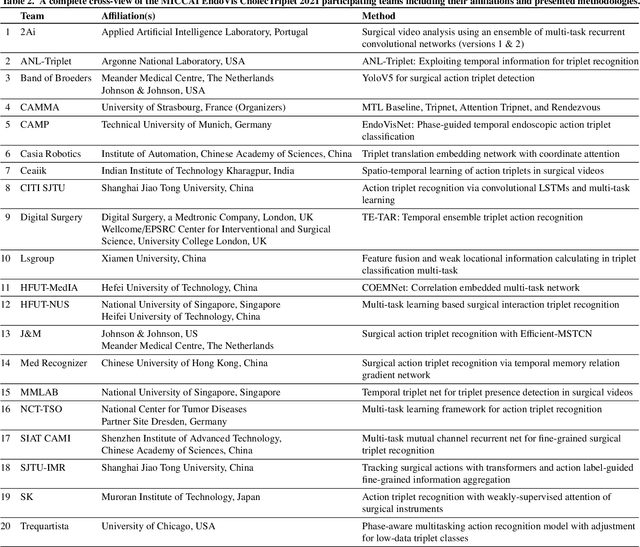Mohammad Hasan Sarhan
SF-TMN: SlowFast Temporal Modeling Network for Surgical Phase Recognition
Jun 15, 2023Abstract:Automatic surgical phase recognition is one of the key technologies to support Video-Based Assessment (VBA) systems for surgical education. Utilizing temporal information is crucial for surgical phase recognition, hence various recent approaches extract frame-level features to conduct full video temporal modeling. For better temporal modeling, we propose SlowFast Temporal Modeling Network (SF-TMN) for surgical phase recognition that can not only achieve frame-level full video temporal modeling but also achieve segment-level full video temporal modeling. We employ a feature extraction network, pre-trained on the target dataset, to extract features from video frames as the training data for SF-TMN. The Slow Path in SF-TMN utilizes all frame features for frame temporal modeling. The Fast Path in SF-TMN utilizes segment-level features summarized from frame features for segment temporal modeling. The proposed paradigm is flexible regarding the choice of temporal modeling networks. We explore MS-TCN and ASFormer models as temporal modeling networks and experiment with multiple combination strategies for Slow and Fast Paths. We evaluate SF-TMN on Cholec80 surgical phase recognition task and demonstrate that SF-TMN can achieve state-of-the-art results on all considered metrics. SF-TMN with ASFormer backbone outperforms the state-of-the-art Not End-to-End(TCN) method by 2.6% in accuracy and 7.4% in the Jaccard score. We also evaluate SF-TMN on action segmentation datasets including 50salads, GTEA, and Breakfast, and achieve state-of-the-art results. The improvement in the results shows that combining temporal information from both frame level and segment level by refining outputs with temporal refinement stages is beneficial for the temporal modeling of surgical phases.
Video-based Surgical Skills Assessment using Long term Tool Tracking
Jul 05, 2022


Abstract:Mastering the technical skills required to perform surgery is an extremely challenging task. Video-based assessment allows surgeons to receive feedback on their technical skills to facilitate learning and development. Currently, this feedback comes primarily from manual video review, which is time-intensive and limits the feasibility of tracking a surgeon's progress over many cases. In this work, we introduce a motion-based approach to automatically assess surgical skills from surgical case video feed. The proposed pipeline first tracks surgical tools reliably to create motion trajectories and then uses those trajectories to predict surgeon technical skill levels. The tracking algorithm employs a simple yet effective re-identification module that improves ID-switch compared to other state-of-the-art methods. This is critical for creating reliable tool trajectories when instruments regularly move on- and off-screen or are periodically obscured. The motion-based classification model employs a state-of-the-art self-attention transformer network to capture short- and long-term motion patterns that are essential for skill evaluation. The proposed method is evaluated on an in-vivo (Cholec80) dataset where an expert-rated GOALS skill assessment of the Calot Triangle Dissection is used as a quantitative skill measure. We compare transformer-based skill assessment with traditional machine learning approaches using the proposed and state-of-the-art tracking. Our result suggests that using motion trajectories from reliable tracking methods is beneficial for assessing surgeon skills based solely on video streams.
CholecTriplet2021: A benchmark challenge for surgical action triplet recognition
Apr 10, 2022



Abstract:Context-aware decision support in the operating room can foster surgical safety and efficiency by leveraging real-time feedback from surgical workflow analysis. Most existing works recognize surgical activities at a coarse-grained level, such as phases, steps or events, leaving out fine-grained interaction details about the surgical activity; yet those are needed for more helpful AI assistance in the operating room. Recognizing surgical actions as triplets of <instrument, verb, target> combination delivers comprehensive details about the activities taking place in surgical videos. This paper presents CholecTriplet2021: an endoscopic vision challenge organized at MICCAI 2021 for the recognition of surgical action triplets in laparoscopic videos. The challenge granted private access to the large-scale CholecT50 dataset, which is annotated with action triplet information. In this paper, we present the challenge setup and assessment of the state-of-the-art deep learning methods proposed by the participants during the challenge. A total of 4 baseline methods from the challenge organizers and 19 new deep learning algorithms by competing teams are presented to recognize surgical action triplets directly from surgical videos, achieving mean average precision (mAP) ranging from 4.2% to 38.1%. This study also analyzes the significance of the results obtained by the presented approaches, performs a thorough methodological comparison between them, in-depth result analysis, and proposes a novel ensemble method for enhanced recognition. Our analysis shows that surgical workflow analysis is not yet solved, and also highlights interesting directions for future research on fine-grained surgical activity recognition which is of utmost importance for the development of AI in surgery.
 Add to Chrome
Add to Chrome Add to Firefox
Add to Firefox Add to Edge
Add to Edge